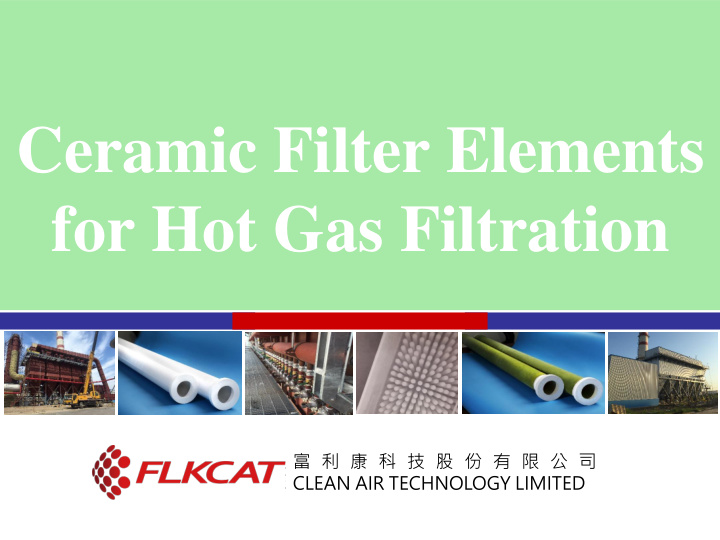



Ceramic Filter Elements for Hot Gas Filtration 富 利 康 科 技 股 份 有 限 公 司 富利康科技股份有限公司 CLEAN AIR TECHNOLOGY LIMITED
About FLKCAT Ltd A new company entering the air pollution control sector Aim to supply the best technologies for monitoring and controlling air pollution Operating globally Experienced personal – proven technologies Technical partnerships – commercial strength Speciality is ceramic filters with integrated catalysts 2
Air pollution control Technology used to control emissions from industrial sites to atmosphere for over 100 years Particulate control market dominated by electrostatic precipitators and fabric filters Others include cyclones, scrubbers, metal filters and ceramic filters – specialist techniques for specialist applications Our area of speciality and the subject of today’s presentation is ceramic filters with integrated catalysts for industrial air pollution control 3
What are ceramic filters? Many types of ceramic products used for filtration Honeycomb filters – engines Dense ceramics used in high pressure high temperature applications We are focussing on products made with ceramic or mineral fibres – formed into tubes/candles Compatible with standard bag filter design concepts Good with “high” dust duties 4
FLKCAT Ceramic Filter Products 5
Ceramic filter features Highly porous One piece construction High Efficiency particulate removal Chemically almost inert High temperature resistance Longest product 3 meters long Rigid otherwise works like a fabric bag Used with a sorbent can remove acid gases such as SOx and HCl Combined with a catalyst can remove pollutants such as NOx and dioxins 6
Dust removal Some particulate penetrates the surface and acts as a barrier to further dust penetration Dust accumulates on the surface and is removed by cleaning pulses Non-blinding High efficiency 7
Acid gas removal Sorbent such as hydrated lime Ca(OH) 2 added as particulate to gas stream Sorbent accumulates on the filter element surface Pollutants such as SOx and HCl must pass through dust cake, and are neutralised by sorbent Spent sorbent is removed by cleaning pulses 8
Catalyst filter for DeNOx Catalyst distributed throughout filter element structure Ammonia added to gas stream to remove NOx Pollutants must pass through filter and, in doing so, come into contact with the catalyst NOx and dioxins are converted into harmless products, such as nitrogen and water 9
Advantages – eliminates catalyst failure modes Catalyst is protected against the poisons such as As Se Na and K because dust stays on filter surface Catalyst is protected against dust blockage and blinding Catalyst life is extended >5 years expected Catalyst evenly distributed 10
Filter properties recap Features Benefits Ceramic composition Chemically inert with HF only known hazard Maximum temperature of operation 900 o C Filter made from ceramic The use of fibres gives the best balance of high efficiency and resistance to flow fibres Rigid filter element A support cage is not required A surface dust layer provides high efficiency dust removal. Less than 2 mg/Nm 3 is typical. Non-blinding due to the surface dust layer, which gives long product life. 5 years and over is not untypical. Small fibre diameter and surface dust layer ensures that even submicron particulates are captured. The use of a sorbent gives an excellent bed for acid gas removal. High removal efficiencies can be obtained at higher temperatures of operation, with greater than 90% efficiencies readily achievable. Manufactured in one piece No weak points such as bag stitching seams Tubular shape Compatible with standard bag house designs Catalyst embedded into Catalyst has high conversion efficiency for NOx and organic compounds Optimal operation temperature of 350 o c the filter element Filter prevents poisoning of catalyst Filter prevents masking of catalyst by dust particles No chemical reaction between catalyst and ceramic filter Nano sized catalyst particles present highly active catalyst sites High performance achieved through no diffusion restriction 11
Performance 12
Technology options ESP SCR 稀釋空氣 DeNox 350 ℃ DeSOx SCR 冷却系統 Bag filter De-Dust Waste Gas 200 ℃ 熱交換系統 Catalyst Ceramic Heat filter recovery 350 ℃ System 13
Ceramic filtration markets Market driver is Legislation Incineration – WID Glass – “Glass BREF” MACT Process efficiency gains Improved product Hot gas with value – energy recovery Energy savings 14
Markets Catalytic ceramic element - Ceramic element – dust dust, SOx & NOx removal and SOx removal Incinerators Glass furnaces Gasification Cement Waste to energy Diesel engines Metallurgical Power generation Product recovery Process filtration 15
Glass Market • Proven product offering • Proven benefits • Design refined • Established references • Established networks • Dust SOx and NOx • Market knowledge 16
Advantages Highest level of efficiency – no visible dust High temperature capability up to 900 o C with dust filter and up to 350 o C with the catalyst Multi-functional – removes dust SOx NOx HCl VOCs in one single step in one piece of equipment with excellent efficiency levels Smaller footprint Opportunities to save capital cost and operational costs 17
Key product features and benefits The combination of ceramic filter and deNOx catalyst is a powerful combination Considerable technical advantages over other technologies Commercial advantages over other technologies “Cheaper and better” is possible Good for dust, SOx and NOx applications Reliable and high performance Long life expected Growing market 18
Conclusions Proven technology Hundreds of references Superior technical performance Savings possible on capital and operational costs Known performance Long life of product Technical back up from first class team The ultimate multi-pollutant control technology 19
Glass Factory Right: catalyst ceramic filter applied Left: not applied TSYP , China , 2015 20
Recommend
More recommend